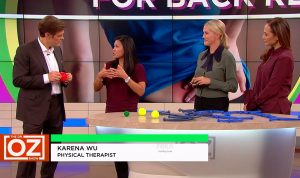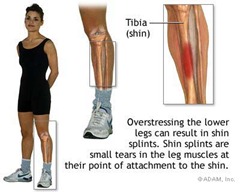 ActiveCare Physical Therapy, PC
ActiveCare Physical Therapy, PC
29 West 38th Street
Suite 601
New York, NY 10018

Physical Therapy and Shin Splints
It’s spring and that means everyone is getting out and walking and running. ActiveCare Physical Therapists are treating a lot of outdoor activity induced injuries secondary to the warm weather. People are more active, but not necessarily conditioned for sports play and therefore, can become injured quickly. And a common injury this time of year is shin splints.
During the swing phase of gait, the front shin muscle, the anterior tibialis contracts to lift the toes up so that you don’t trip as you progress the leg forward. A shin splint occurs when the front of the shin gets overstressed and overused from lifting the toes during walking or running. It is also known as Medial Tibial Stress Syndrome. It feels like the shin is splintering, especially as the muscle becomes fatigued and cannot absorb the impact forces when the foot hits the ground. Eventually, the tibial bone can actually bend or bow and the muscle can pull away from the bone a bit.
 Shin splints can happen when people start training, especially if they are not conditioned well. To protect the shins, you need to be strong in the larger muscle groups like hips and knees and flexible in the opposing muscles.
Shin splints can happen when people start training, especially if they are not conditioned well. To protect the shins, you need to be strong in the larger muscle groups like hips and knees and flexible in the opposing muscles.
When you aren’t strong in the large muscle groups, the little muscles have to work harder to complete the movement. The smaller muscles take more energy to contract and don’t last as long during an exercise. The larger muscles, on the other hand use less energy and last much longer during an exercise. Also, when the two calf muscles (called the gastrocnemius-soleus complex) are too tight, the anterior tibialis or front of the shin can get overworked. The anterior tibialis has to work harder to lift the toes into a range of motion that is not as easy to access. This inefficiency in using the wrong muscles leads to more potential for injury.
One exercise to avoid and repair shin splints is to do a stretch of both the anterior tib and the gastrocs. This includes the runner’s stretch and the anterior tib stretch.
For strengthening, you can do heel/toe raises and walking and regular squats without weights.
Physical Therapy modalities as well as manual therapies help in the initial phase of this injury. Be patient in allowing this injury to heal as it will let you continue running for the rest of the summer without pain. If you have any more questions, remember to ask your local Physical Therapist.
To learn more about physical therapy, visit us at BestPTNYC.com.
P.S. Participate in the Arthritis Walk with us on June 23 in Battery Park! If you cannot walk, a donation would help us out in the PT Practice Challenge in Prevention of Arthritis. Deadline for donation is June 10th. For more info, visit our team page under ActiveCare Physical Therapy at: www.newyorkaw.kintera.org.
